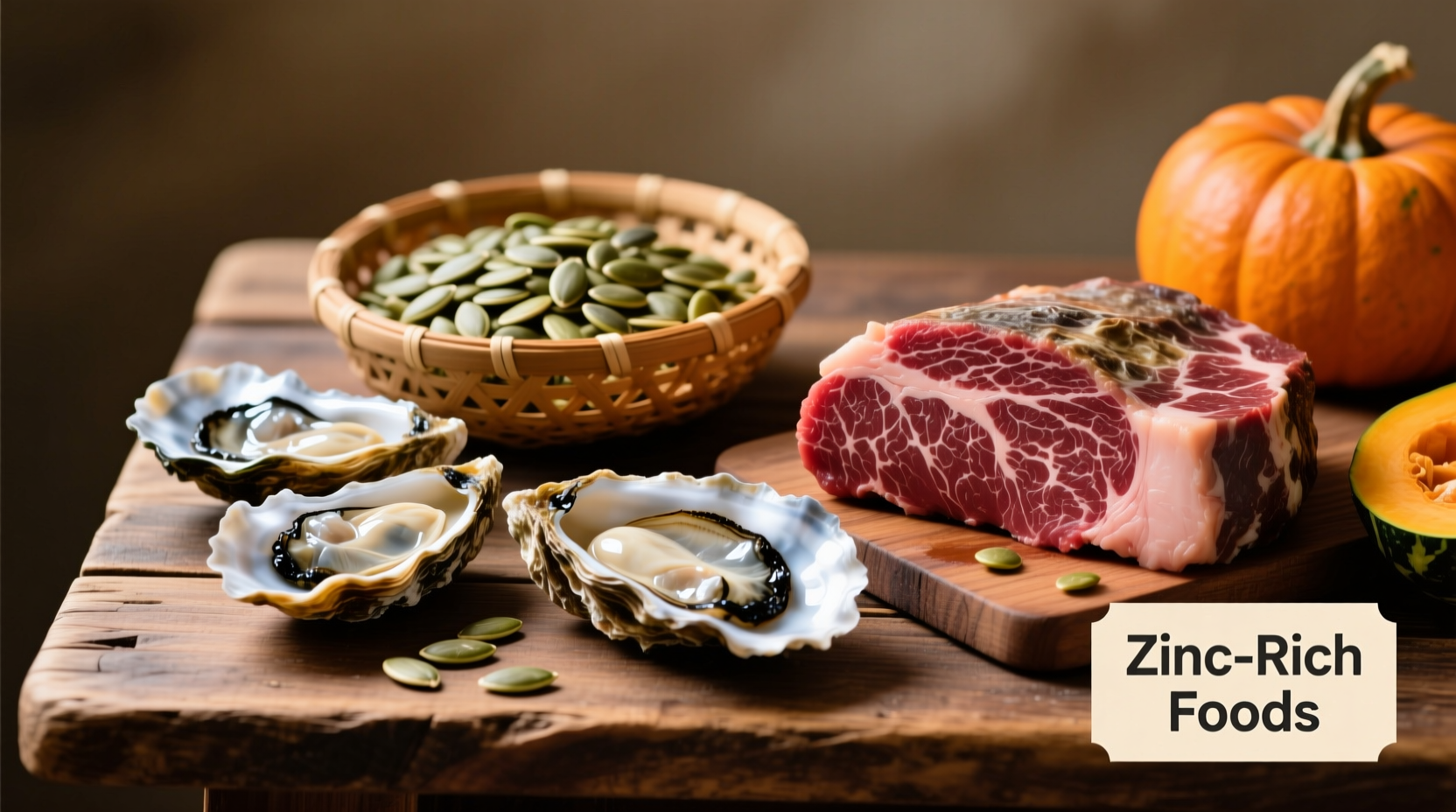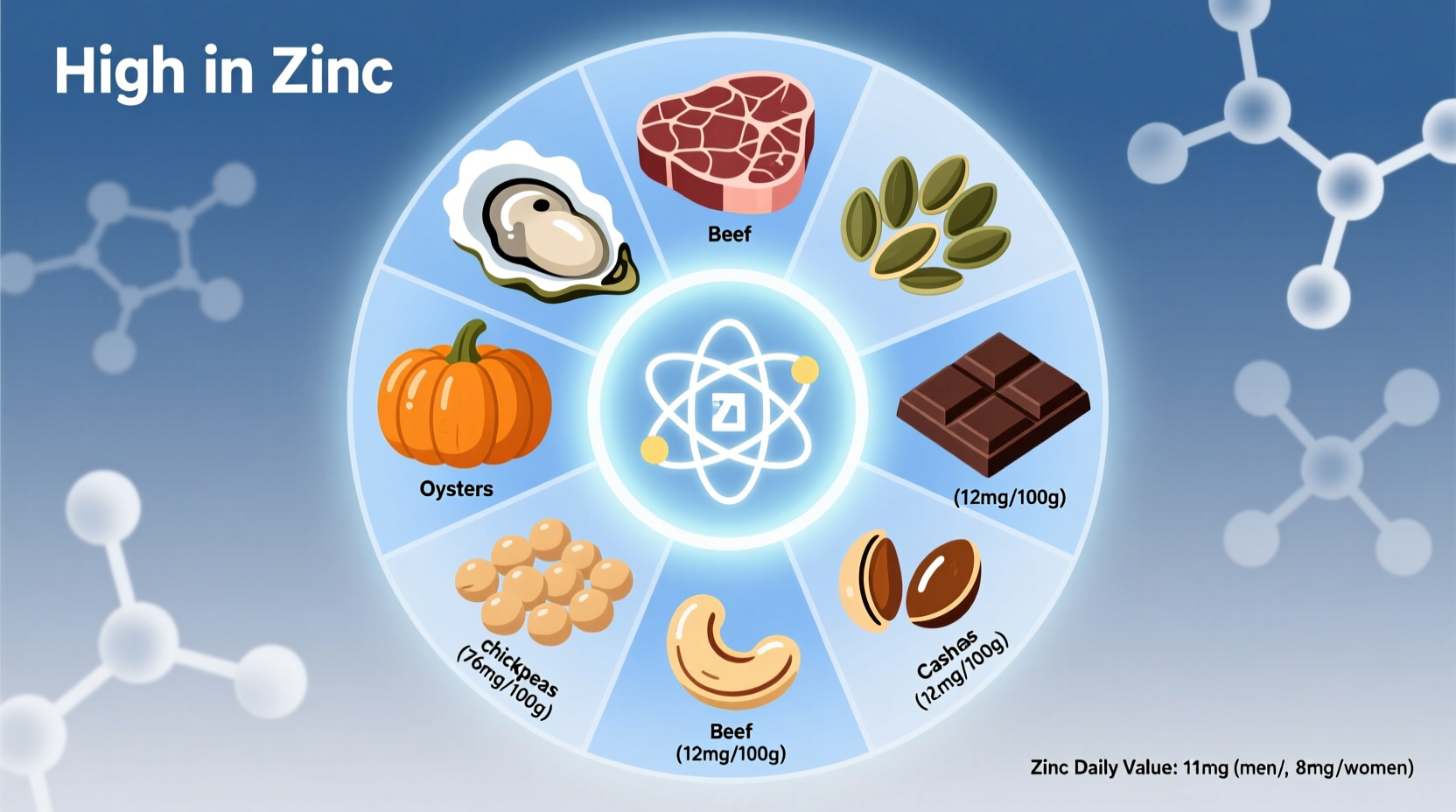Discover exactly which foods deliver the most zinc per serving and how to optimize your intake for better immunity, wound healing, and overall health. Whether you're addressing a deficiency, following a plant-based diet, or simply optimizing your nutrition, this evidence-based guide provides actionable information you can use immediately.
Why Zinc Matters for Your Health
Zinc plays a critical role in over 300 enzymatic reactions in your body. According to the National Institutes of Health, this essential mineral supports:
- Immune system function - zinc deficiency increases susceptibility to infections
- Wound healing processes - crucial for tissue repair and regeneration
- DNA synthesis and cell division - vital for growth and development
- Sensory functions - maintains proper taste and smell perception
- Hormone regulation - particularly important for reproductive health
Despite its importance, approximately 17% of the global population faces risk of inadequate zinc intake according to World Health Organization data. Certain groups require special attention:
- Vegans and vegetarians (plant-based zinc has lower bioavailability)
- Pregnant and breastfeeding women (increased nutritional demands)
- Older adults (reduced absorption efficiency)
- People with gastrointestinal disorders (Crohn's, ulcerative colitis)

Top Animal-Based Zinc Sources
Animal proteins provide zinc in a form your body absorbs more efficiently (15-40% absorption rate) compared to plant sources. Here are the most concentrated sources:
| Food | Zinc (per standard serving) | % Daily Value |
|---|---|---|
| Oysters, cooked (3 ounces) | 74 mg | 673% |
| Beef chuck roast (3 ounces) | 7.0 mg | 64% |
| Crab (3 ounces) | 6.5 mg | 59% |
| Lobster (3 ounces) | 3.4 mg | 31% |
| Pork chop (3 ounces) | 2.9 mg | 26% |
| Chicken leg (3 ounces) | 2.7 mg | 25% |
Oysters stand as the undisputed champion of zinc content, delivering more than six times the daily requirement in a single serving. Beef provides the most practical everyday source for regular consumption. The USDA FoodData Central confirms that red meat contains zinc in a highly bioavailable form called "zinc cysteine," which your body absorbs more efficiently than other forms.
Best Plant-Based Zinc Options
For vegetarians and vegans, zinc intake requires more strategic planning since plant sources contain phytates that reduce absorption by 20-40%. However, several plant foods remain excellent options when properly prepared:
- Pumpkin seeds - 2.2mg per ounce (20% DV). Soak or roast to reduce phytate content
- Lentils - 1.3mg per ½ cup cooked (12% DV). Pair with vitamin C-rich foods for better absorption
- Cashews - 1.6mg per ounce (15% DV). Opt for soaked or sprouted varieties
- Chickpeas - 1.3mg per ½ cup cooked (12% DV). Fermenting improves bioavailability
- Oats - 1.0mg per ½ cup dry (9% DV). Choose steel-cut for lower phytate content
Research published in the American Journal of Clinical Nutrition shows that soaking, sprouting, or fermenting plant foods can increase zinc absorption by breaking down phytates. For example, sourdough bread provides better zinc availability than regular yeast bread due to the fermentation process.
Maximizing Zinc Absorption From Your Diet
Simply consuming zinc-rich foods isn't enough - your body's ability to absorb this mineral depends on several factors:
Foods That Enhance Zinc Absorption
- Vitamin C-rich foods (citrus, bell peppers, broccoli) consumed simultaneously
- Animal proteins (meat, fish, poultry) which contain absorption-enhancing compounds
- Fermented foods (sourdough, tempeh, miso) that reduce phytate content
Foods That Inhibit Zinc Absorption
- High-phytate foods (whole grains, legumes) consumed without preparation
- Calcium supplements taken with zinc-rich meals (competes for absorption)
- Excessive iron supplements (more than 25mg at one time)
For optimal results, separate high-zinc meals from calcium-rich foods by at least 2 hours. When consuming plant-based zinc sources, pair them with vitamin C-rich foods - try adding lemon juice to lentil soup or bell peppers to bean salads.
Practical Zinc-Rich Meal Planning
Implementing zinc-rich foods into your daily routine doesn't require dramatic changes. These practical strategies work for various dietary preferences:
For Omnivores
- Start your day with Greek yogurt (1.4mg per 8oz) topped with cashews
- Include lean beef or chicken in at least one daily meal
- Enjoy seafood twice weekly (oysters, crab, or lobster)
- Add cheese (1.0mg per ounce) to salads and vegetables
For Vegetarians and Vegans
- Soak and sprout legumes before cooking to reduce phytates
- Include pumpkin seeds as a daily snack (¼ cup provides 40% DV)
- Make zinc-boosting smoothies with cashews, oats, and berries
- Choose sourdough bread instead of regular whole wheat
- Pair lentils with tomatoes (vitamin C) for better absorption
A three-day sample menu might include:
- Day 1: Oatmeal with pumpkin seeds and berries (breakfast), lentil soup with lemon (lunch), cashew stir-fry with broccoli (dinner)
- Day 2: Greek yogurt with cashews (breakfast), chickpea salad sandwich (lunch), beef chili (dinner)
- Day 3: Scrambled eggs with cheese (breakfast), black bean soup (lunch), salmon with roasted vegetables (dinner)
When Food Isn't Enough: Special Considerations
While food should be your primary zinc source, certain situations may warrant supplementation under medical supervision:
- Vegans with consistently low intake despite careful planning
- Individuals with malabsorption conditions (Crohn's, celiac)
- Older adults showing signs of deficiency
- People recovering from severe burns or trauma
The NIH Office of Dietary Supplements cautions against exceeding 40mg daily from supplements without medical supervision, as excessive zinc can cause copper deficiency and immune dysfunction. Always prioritize food sources first and consult a healthcare provider before starting supplements.
Monitoring Your Zinc Status
Recognizing potential zinc deficiency helps you address issues before they become serious. Common signs include:
- Slow wound healing
- Frequent colds and infections
- Loss of appetite
- Impaired sense of taste or smell
- Hair loss
- Skin rashes
If you experience multiple symptoms, consult a healthcare provider for proper testing. Blood tests for zinc aren't always reliable, so providers often consider symptoms alongside dietary assessment. For accurate diagnosis, work with a registered dietitian who can evaluate your complete nutritional picture.











 浙公网安备
33010002000092号
浙公网安备
33010002000092号 浙B2-20120091-4
浙B2-20120091-4